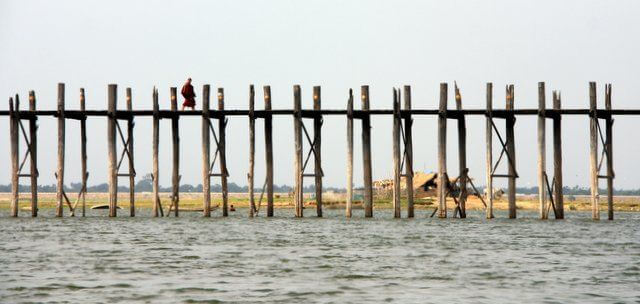
A monk crossing U Bein’s bridge at Amarapura
Mandalay was the last royal capital of Myanmar, but for 50 years before that it was the town of Amarapura, set beside the Taungthaman Lake.
From Mandalay it’s only a short drive along the route of the Irrawaddy River to Amarapura. Arriving by car is tainted by the remarkable number of stalls lining the approach – even before the driver fully stopped, young hands were thrust though the window offering wood carvings and colourful laquerware.

U Bein’s bridge at Amarapura
Once they let us out of the door, it was possible to see the beauty of the surroundings. Amarapura is focused around the Taungthaman Lake. White stupas and golden holy trees line the shore, but the eye is inevitably drawn to the immense teak bridge crossing the lake.
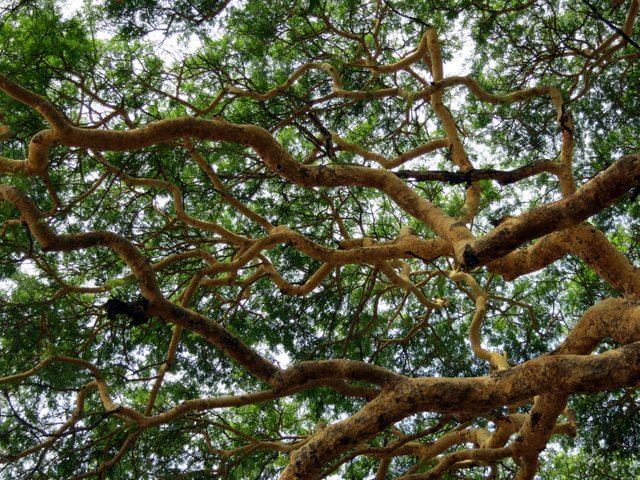
One of the golden trees around Taungthaman Lake – anyone know the species?
Whilst we stood marvelling at the sheer size of the bridge a young chap fell in beside us. He was wearing a t-shirt emblazoned with ‘Nazi Luftwaffe’ which was a bit off-putting, but seemed friendly so we walked along the bridge together.
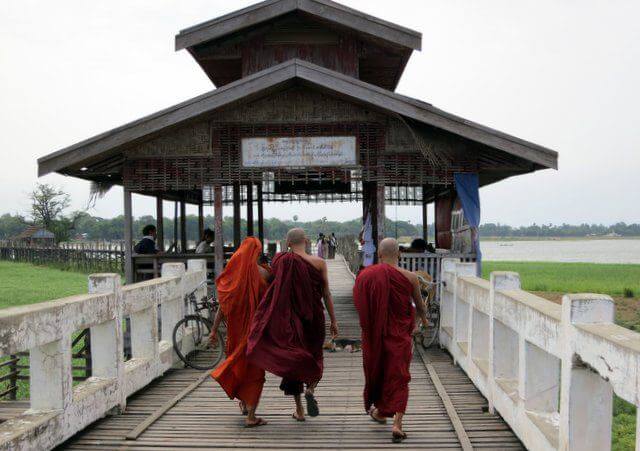
Monks crossing U Bein’s bridge
U Bein’s Bridge
U Bein was a local leader when the capital moved here in 1841, and he led the construction of the teak bridge. The bridge was intended to enable the Amarapuravillagers to cross the lake to the Kyauktawgyi Paya on the far bank.
Two hundred years later it is still the world’s longest teak bridge at 1.2km. Many of the 1,060 upright poles are still originals, but a few small rest stations have been added along the top.
The bridge is still used by monks and fisherman, and villagers have set up stalls in the rest points that dot the crossing. Our guide introduced himself as James, which I assumed wasn’t his real name, but didn’t like to argue.
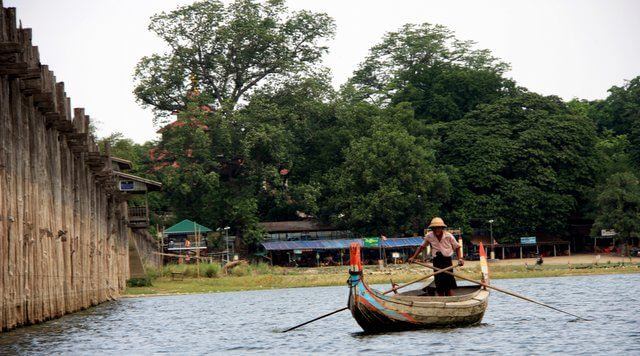
Taungthaman Lake boatman
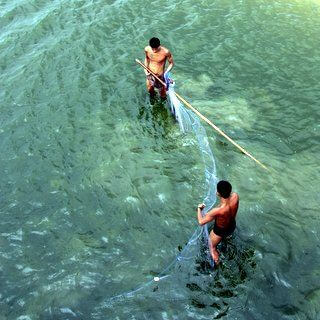
Taungthaman Lake fisherman casting their nets
A lot of waving and shouting later a boatman made his way over to the island and took us aboard.
Rowing across to where the fishermen were casting their nets, we turned to get the more wide view of the lake. Luckily we were just in time to capture one of Myanmar’s most iconic photos – monks crossing U Bein’s bridge.
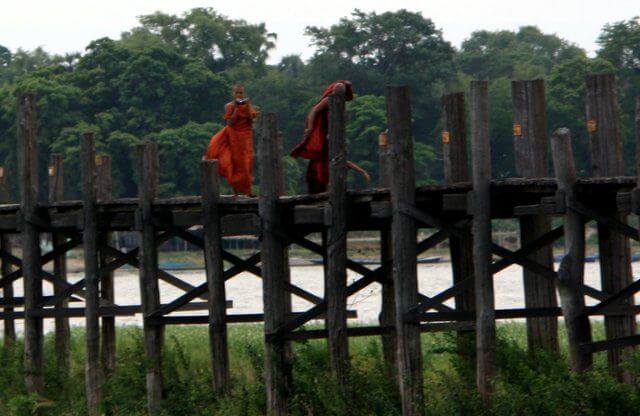
The monks were also lucky enough to get less than iconic photos of us
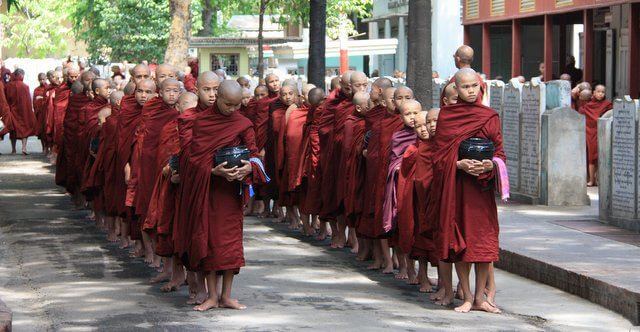
Monks patiently waiting in line at the Maha Ganayon Kyaung Monastery
Maha Ganayon Kyaung Monastery at Amarapura
Not far from where we’d started to cross the bridge is the Maha Ganayon Kyang Monastery.
The monks here are only fed once per day, and the operation is run with military precision. The drill-instructor-like head monk orders the boys to arrange themselves in straight lines. Once everyone is in place they move forward and collect their bowl of food from the smiling ladies in the refectory. Most of the monks sit in the canteen in silence, but a few take their bowls back to the dorms.
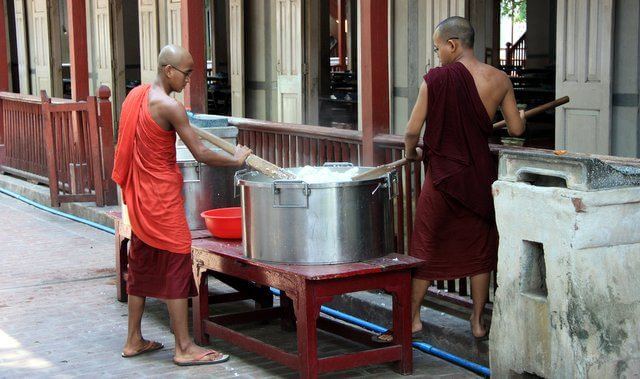
Preparing the rice
I’m not sure what this routine is supposed to teach the monks apart from discipline. It definitely teaches them to be wary of tourists with large cameras.
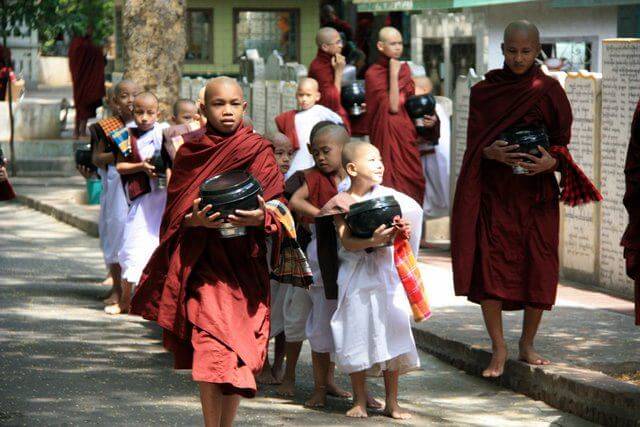
Monks lining up for their daily meal
Rather like at the Pindaya Caves a French tour group rolled up in a minibus, and ran amongst the monks sticking their cameras in the faces of the young boys. The head monk tried to shoo them away but was rudely jostled out of the way of the photo they wanted.
It’s becoming a common theme in Myanmar, the Burmese people are gentle and welcoming, and the tourists treat them so badly.
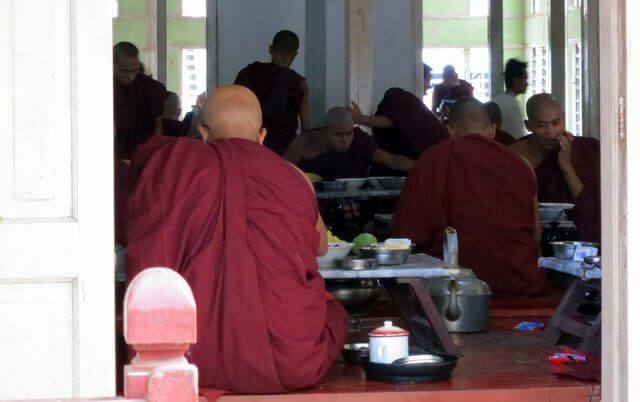
The monks eat in silence






Pingback: @peterzburg
Pingback: @IndochinaTravel
Pingback: Micki & Charles (@BarefootNomads)
Pingback: Dr. Jessica Voigts (@WanderingEds)
incredible photos! and i can’t blv how rude some tourists can be. UGH!
Pingback: @escapeartistes
U Bein is amazing bridge (and the photos are pretty amazing, too).
Gorgeous pics….loving your posts from Myanmar!
Pingback: @acceleratedstal
Wow! Love the bridge but the colors and textures are sweeping me aaawwwaaayyy! Thnx
Pingback: Green Global Travel (@GreenGlobalTrvl)